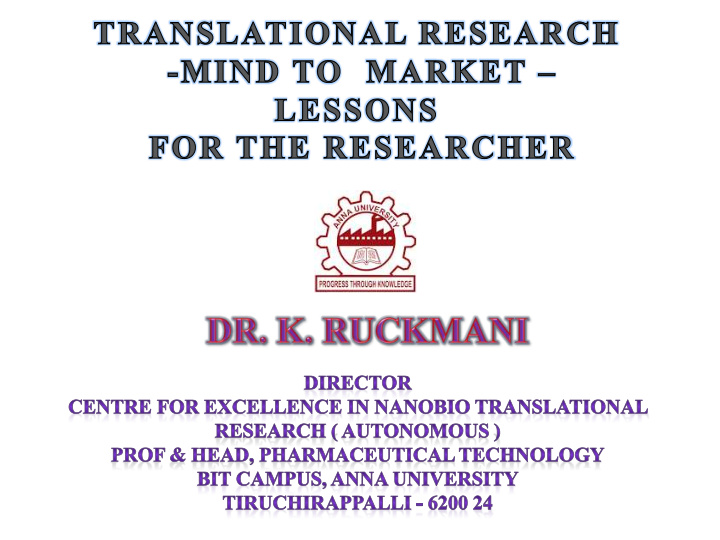



Translational Research Platform TRANSLATIONAL RESEARCH ‘Translation’ refers to the application of the results of basic biomedical research to the practice of medicine. It is the process of converting discoveries made in the laboratory into clinical interventions that provide a direct benefit to human health. Bridging the gap between the discoveries achieved at the ‘ bench’ and interventions and therapies at the ‘ bedside’ remain a challenge . Translational Research is a two-way process to translate discoveries into clinical application and the translation of clinical findings into the understanding of molecular mechanisms. Definition: “Investigation of methods, interventions and variables that influence adoption by individuals and organizations of evidence-based practices to improve clinical and operational decision making in health care.” ( Titler, 2008, p. 1- 115-1-116).
Translational Research Platform Translational research, “ transforms scientific discoveries arising from the laboratory, clinical, or population studies into clinical applications …” (Source: National Cancer Institute, National Institutes of Health)
Translational Research Translational Research Figure 1 Model for translational research, as proposed by the Evaluation Committee of the Association for Clinical Research Training. 8 • T1 research seeks to foster new or improved scientific understanding or patient care. • T2 research facilitates improved patient outcomes, optimization of medical practices, and improved community health. • T3 research promotes further scientific understanding of human health and disease.
Translational Research Platform TRANSLATIONAL RESEARCH PHASE Dougherty, D. et al. JAMA 2008;299:2319-2321
Translational Research Platform IDEA Universities Start-up Firms Research Institutes R & D Firms Larger Companies MARKET
Translational Research Platform Teaching Individual career Research ambitions Competing for Publishing grants To do this, the basic motive to do research has to change in terms of ‘addressing an unmet need’ and not to start with an already available publication .
Translational Research Platform Product/Market Fit Technology and Technology Value Proposition Product Issues Business/Market Partnership Development Factors Intellectual Property Strong IP Position Challenges SUCCESSFUL INNOVATIONS
Translational Research Platform Thinking about innovative process and outcome value Knowledge Sharing Mentoring; counseling student-lead research Capture of process Users of student generated materials Connecting teams Facilitating Project Development Publishable Research Teaching case or Examples Documentation- Process, Case Studies, Broader Impacts Training Communication- Internal & External
Translational Research Platform REMARK S S. COMMERCIALIZATION SCORE No. PARAMETER I. a Fulfilling an unmet need 25 New vaccine or disease diagnostics that is not so far available I. b Reducing existing cost with 20 Reverse engineering; import substitute equivalent performance Improving existing performance – I. c 15 Mab-based cELISA improves specificity; overcomes lacunae DIVA II Novel - IP protected 25 More so for multinationals III Fulfilling regulatory requirements 10 Milk adulteration; Fat / protein content; Bull testing; RFFIT; canine parentage IV Availability of complete portfolio 15 Not restricted to only one disease diagnosis but for other related diseases also User-friendly; POC – strip test, FPA V Ease and market of technology 12.5 adoption For bulk production – Mabs, recombinant VI Availability of raw materials / 7.5 ingredients proteins; tuberculin etc. VII Create awareness / Aggressive 5 Users need to know of availability Marketing
SCIENCE TECHNOLOGY BUSINESS IP REGULATION Demand and buying capacity Changing priorities Technologies change rapidly
Translational Research Platform PRODUCTS PROCESSES More impact Less impact User friendly Sample collection, transport, time etc. more critical Field based Laboratory POC (Proof of Concept) Time lag Characterization – sexing, Disease diagnosis A1/A2, parentage Need to be technologically Can be technologically more less demanding demanding
Translational Research Platform Technology landscaping – Understand what is occurring in your technological area: • technological trends • subjects of research • emerging research fields – Avoid reinventing the wheels • find existing solutions to a technical problem • find solutions that are not yet protected – Watch your competitors • key players • patent portfolios • technical strategies – Survey third parties patents • patenting trends • threats • infringements
Translational Research Platform • Thinking ‘backwards’ – ‘market to mind’ • Pose several questions in your research area • Identify priorities • Do a technology landscaping • Do a FTO (freedom to operate) search / strategy • Then do the ‘science’ – Be willing to accept failures • Immediately protect the ‘science’ through IPR • Do a mutually trusting collaboration especially with industry – ‘win - win’ situation for both parties • Satisfy regulatory requirements
COMPULSORY LICENSING • section 84 (a) that the reasonable requirements of the public with respect to the patented invention have not been satisfied, or (b) that the patented invention is not available to the public at a reasonably affordable price, or (c) that the patented invention is not worked in the territory of India.
Supreme Court says no to Bayer, upholds compulsory license on Nexavar • anti-cancer drug – sorafenib tosylate • crucial drug for patients living with kidney and liver cancer • Bayer - Rs. 2,80,000 per month per patient. • Natco - Rs. 8, 800 per person per year • 8842 in one yr vs 200 in 3 yrs
Translational Research Platform CASE STUDY – 1 “ Herbal exfoliating composition comprising Phaseolus mungo and Cyphomandra betaceae ” Indian Patent No: 292860
Translational Research Platform CASE STUDY – 2 Novel and stable pharmaceutical composition of vitamin A analogs . Patent filed no. : 813/CHE/2011
CASE STUDY – 3 Patent No.: US 8,999,384 B2
Arise, Awake, Stop not till the goal is reached - Swami Vivekananda
21
Recommend
More recommend